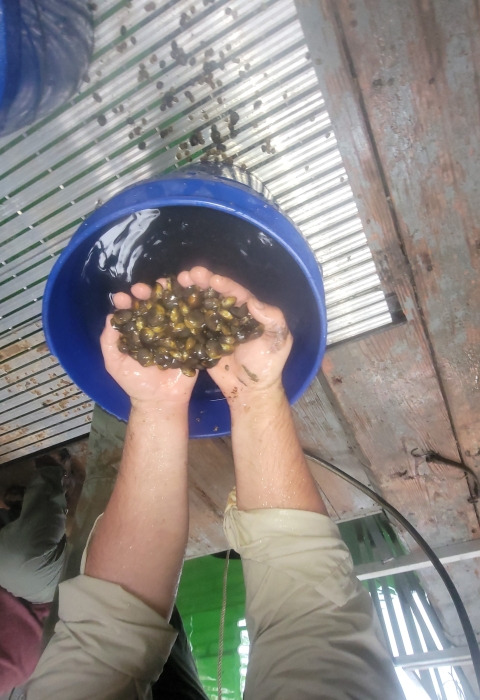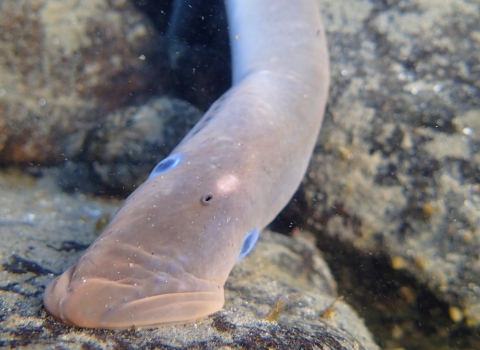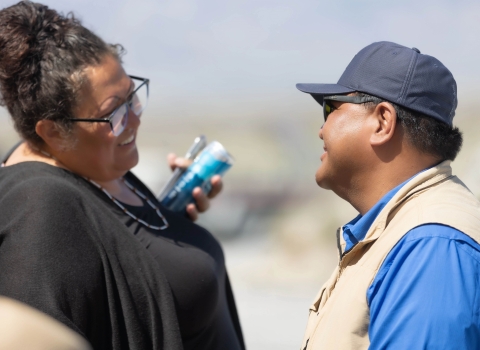This year's list of the newly added or new rearing method experimental mussel lots:
29 - Duck River dartersnapper (Epioblasma ahlstedti)
40 - Sheepnose (Plethobasus cyphyus)
110 - Round hickorynut (Obovaria subrotunda)
2,388 - Pale lilliput pearlymussel (Toxolasma cylindrellus)
6 - Rough pigtoe (Pleurobema plenum)
15 - Pink mucket pearlymussel (Lampsilis abrupta)
271 - Cumberland moccasinshell (Medionidus conradicus)
6 - Purple cat’s paw pearlymussel (Epioblasma obliquata)
Tennessee Wildlife Resource Agency mussel crew with station staff labor assistance had double the walking and working space this year making the mussel work far easier, safer, and faster. The deep clean and organizing really helps the process and having a pressure washer and tools to clean/repair cages on site allowed for immediate turnaround re-use easily saving two days of labor hauling everything back and forth, setup, and cleanup. The majority of the mussels initially planted this year are the result of the invitro rearing at the Cumberland River Aquatic Center using fish blood from a number of host species. This was followed up by the rapid building of a new cage and planting some infested host fish a few days later.
We have a few thousand specimen on station being reared for grow-out that we will harvest, count and return to rivers in mid/late September.
The Boat house upgrades where done using mostly physical labor and as little money as was reasonable - we had to buy a low cost 110v sump pump and electric pressure washer to clean the cages, but most of the fabrication for the new working plank, barge, hoist rail system and building organization was done with on-station supplies or donations from the hatchery friends group.
The cages at Dale Hollow have been on the repair list for over a year as the original cage metal is rusting out and dangerous to handle, cutting anyone that touches the material with bare hands. We’ve been re-building cages every couple weeks and trying out a number of pre-made alternatives. So far nothing compares to quality available with using the aluminum frames. The perforated screen material makes lifetime quality cages but is costly to produce. The station is using a combination of short lifespan siding materials and as funds and spare aluminum is available building the higher quality perma-cages. Staff will continue to experiment if fabrication, innovation, and off the shelf alternatives and has generated a combination cage inventory summary and funding assistance solicitation.
We sent out a funding request for our partners to help us find some used aluminum or maybe even help us fund getting some new stock material and got an offer from the state to help us get some of the cage outer shell material.
The station is on hold for all spending and only has enough material on hand for 3 more cage rebuilds with mesh that does not cut employees, starve the mussels or rust out. Funding required for most of the cage inventory repairs for aluminum and material delivery cost (Does not include the cage frames, fasteners, fabrication, planned to be supplied by the station and recruited volunteers as possible)
Info regarding cage repair material
• Sized close to the small mesh size of the current cages, similar to the cages built at Wolf Creek and Norfork Cost is based on aluminum and non-designer mesh material
• Takes a sheet per cage, last time we bought these at around $426-460 each, it is likely more now.
• We have over 50 cages to rebuild, but can start with whatever number we can afford to fund this year, especially if we keep trying some low cost material alternatives with high durability
• These will continue to be the base hatchery cage; newer models will find ways to reduce required materials (laundry baskets and pyramids)
• Additional cost is to order 1" aluminum strap that can save some fabrication time. 4 bars per cage affixed to dual long sides of each face
Hatchery funds for this year's mussel work will be spent out soon and we'll hit a brick wall on costs. I think the best option is to pool our collective money and place an order for all of the aluminum strap and 90o angles we'll need and then as many of the perforated aluminum sheets as we can afford together for the year.
I'll send out another group email tomorrow with how much we have left that we can spend on supplies, and we can give both TWRA and FAC the chance to support the cage repair effort however they choose.
Material plan (will want to read to bottom before checking links):
- We buy 45 square tube and I make a jig to cut them in half and use as angle
- 1.25"x0.125" Aluminum 96" (8ft) square-stock length
We will continue the work path in front of us, rebuilding cages, improving the boat house, growing the hatchery transport contributions, and pushing to increase annual stocking numbers based on the capability growth from the hard work of hatchery staff and state partners.



